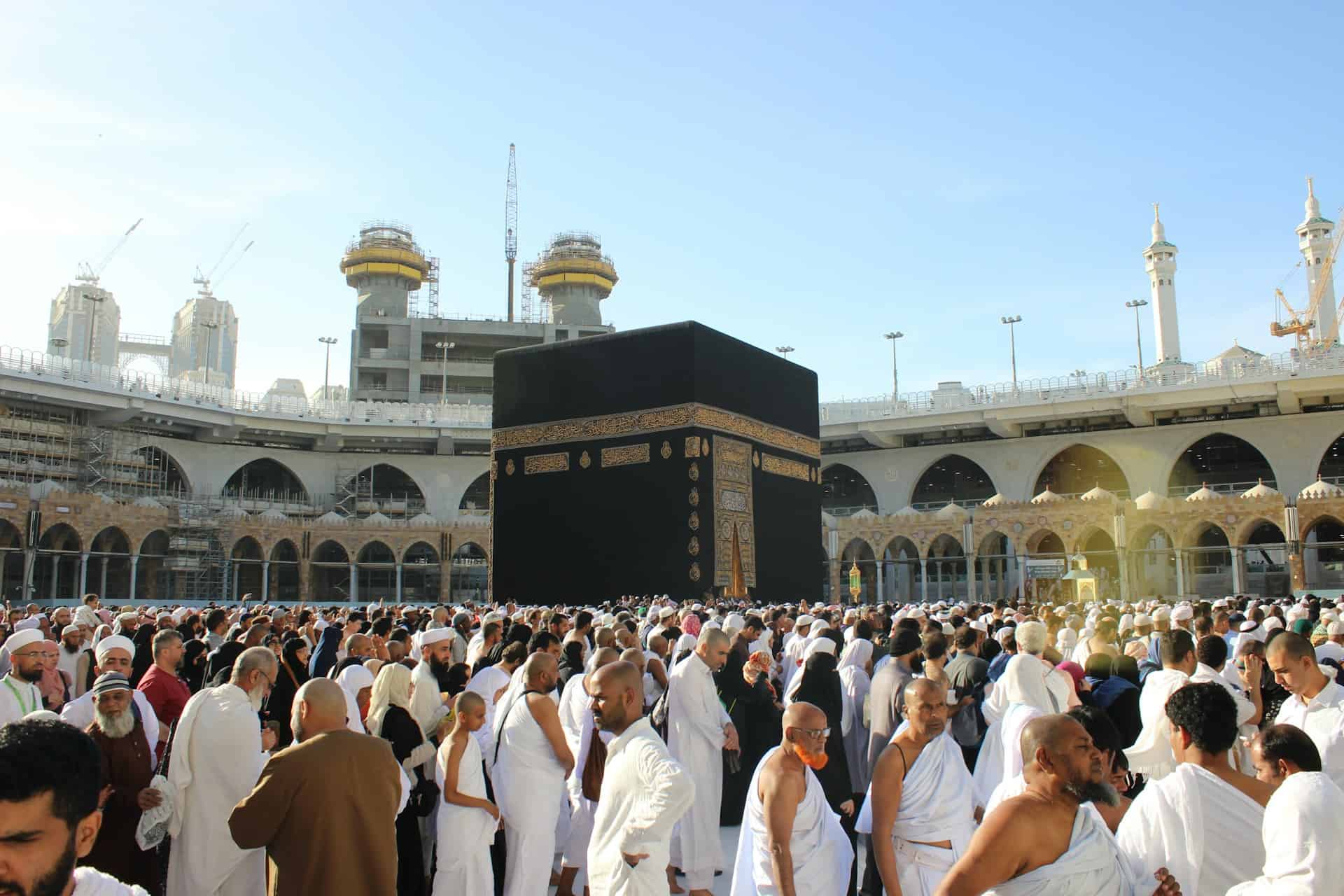Hajj Ifrad Guide: How to Perform Hajj al-Ifrad Without Umrah
In the Name of Allah—the Most Compassionate, Most Merciful.
Hajj Ifrad is one of the three valid ways to perform the Hajj pilgrimage.
This hajj type focuses on completing Hajj by itself, without combining it with Umrah or exiting the state of Ihram until all rites are completed. The pilgrim stays in Ihram through all the required Hajj days, performs the rites in sequence, and is not obligated to offer an animal sacrifice.
There is no break between rituals, the second Ihram, or added steps. This method is especially common among those living near Masjid al-Haram or surrounding areas like Madinah, though it is a valid choice for any qualified pilgrim.
In this Hajj guide, we will explain Hajj al-Ifrad in detail and how it differs from other methods, such as Tamattu and Ifrad Qiran.
What Is Hajj Ifrad and Who Can Perform It?
Hajj al-Ifrad is one of the three recognised pilgrimage methods and is a distinct Hajj type. In this form, the pilgrim enters into Ihram to perform Hajj al-Ifrad only, without combining it with Umrah.
This method is often selected by residents of Madinah or the surrounding regions, especially those near Masjid al-Haram, but it remains valid for all Muslims regardless of origin.
As detailed in any reliable Hajj guide, the process starts at the Miqat, where the pilgrim recites the Talbiyah for Hajj al-Ifrad and enters Ihram. Unlike Ifrad Qiran, this method does not require a sacrifice and does not include Umrah before or after.
The pilgrim remains in Ihram throughout the Hajj days until the rituals are fully completed.
Hajj-ul Ifrad is considered part of the Hajj general rulings and emphasises a direct, uninterrupted focus on Hajj alone.
It avoids the combined structure of Ifrad Qiran, allowing pilgrims to complete their obligation with fewer logistical steps and without the layering of rituals found in other forms.
Meaning of Ifrad in the Context of Hajj
“Ifrad” in Arabic means “to single out” or “to isolate.” In the context of Hajj, it refers to singling out the Hajj rites without combining them with Umrah.
When someone performs Hajj Ifrad, they dedicate their entire pilgrimage to Hajj alone, avoiding the dual commitment that comes with Qiran or Tamattu.
The term emphasises simplicity and singular devotion. Unlike other methods that involve combining or sequencing, Ifrad separates Hajj as a standalone act of worship.
The idea is not to mix the rituals of Umrah and Hajj, but to perform each in its own time, with Hajj being the focus.
“Scholars often recommend Ifrad for those who live close to Makkah due to the ease of accessing Umrah at another time. It reduces logistical complexity and fits well within residents’ obligations.”
Step-by-Step Process for Performing Hajj Ifrad
The steps involved in Hajj Ifrad follow a fixed sequence and must be observed in the correct order. Below is a clear breakdown:
- Enter the state of Ihram at the Miqat with the intention of Hajj only.
- Recite the Talbiyah continuously until reaching Makkah.
- Perform Tawaf al-Qudum (arrival Tawaf) upon entering the Masjid.
- After Tawaf, perform two Rakaat behind Maqam Ibrahim if possible.
- Perform Sa’i between Safa and Marwah. You may delay Sa’i until after Tawaf al-Ifadah.
- Remain in Ihram and avoid all restricted acts until the days of Hajj begin.
- On 8th Dhul Hijjah (Yawm al-Tarwiyah), travel to Mina and stay overnight.
- On 9th Dhul Hijjah, proceed to Arafat for the standing (Wuquf).
- After sunset, head to Muzdalifah and collect pebbles.
- On 10th Dhul Hijjah, stone Jamrat al-Aqabah, then trim or shave the hair (for men).
- Perform Tawaf al-Ifadah in Makkah, followed by Sa’i (if not done earlier).
- Continue stoning at Mina on 11th and 12th, and optionally 13th.
- Perform the farewell Tawaf (Tawaf al-Wada) before leaving.
This is the complete order for Hajj Ifrad without combining Umrah.
Difference Between Hajj Ifrad and Tamattu
The distinction between Hajj Ifrad and Hajj Tamattu is rooted in intention, sequence, and the management of Ihram.
In Hajj Ifrad, pilgrims enter Ihram solely for Hajj, with no plan to perform Umrah during the same trip. Once they cross the Miqat, they remain in Ihram throughout the pilgrimage until after completing the Tawaf al-Ifadah and other rites.
This means no shaving or trimming, no relaxation from restrictions, and no breaks. The focus is on Hajj, done in its complete form, without any preceding Umrah.
Hajj Tamattu, however, introduces a two-part sequence. First, the pilgrim enters Ihram with the intention of Umrah. Upon reaching Makkah, they perform Tawaf, Sa’i, then shave or trim their hair and exit Ihram.
This break allows the pilgrim to spend several days free from restrictions. On the 8th of Dhul Hijjah, they re-enter Ihram, this time for Hajj, and continue with the rest of the pilgrimage. Essentially, two separate rituals are performed in one trip, each with its own Ihram.
A major operational difference involves animal sacrifice. Hajj Tamattu requires a sacrifice as part of its completion. It is a binding part of the ritual, not optional. This includes slaughtering a goat or sheep, or contributing to a larger sacrifice. In Hajj Ifrad, there is no such obligation.
A sacrifice may still be offered, but it is considered voluntary. For budget-conscious pilgrims, this difference can impact planning. Not just financially but logistically, arranging a sacrifice in Saudi Arabia can require coordination, timing, or booking through an agent.
The duration in Ihram is also a significant factor. In Hajj Ifrad, the pilgrim remains in Ihram from the start to near the end, which means several days of adhering to strict conditions: no perfumes, no shaving, no cutting nails, no sexual relations, no stitched clothing for men, and more. For some, especially the elderly or first-time pilgrims, staying in Ihram for so long can be physically and mentally demanding.
In Tamattu, the pilgrim gets a break between Umrah and Hajj, which allows them to rest, regroup, and prepare.
There’s also a difference in the spiritual rhythm of the journey.
Hajj Tamattu offers an early spiritual lift through Umrah, which is completed upon arrival. Many feel that starting with Umrah allows them to ease into the pilgrimage experience.
By the time Hajj begins, they’ve already adjusted to the environment, rituals, and flow of Makkah. In contrast, Hajj Ifrad can feel more intense.
There is no gradual build-up; the pilgrim is in a constant state of pilgrimage from beginning to end, with no intermediate pause.
Geography plays a role in what pilgrims choose. Hajj Tamattu is the default for most international pilgrims. It makes sense logistically—perform Umrah, wait a few days, and then perform Hajj without needing to extend the trip or come again.
The Saudi visa policies also influence this; many pilgrims receive a haj visa allowing only a limited stay, so combining Umrah and Hajj is practical. In contrast, Hajj Ifrad is usually favoured by those living in Makkah or nearby regions like Jeddah or Taif, who can perform Umrah anytime.
For them, doing Hajj without Umrah reduces time, complexity, and cost.
Both methods are valid and equally accepted in Islamic law.
Scholars from different schools have preferred one, but there is no obligation to pick a specific type unless it is dictated by circumstance.
What matters is intention, correct execution, and sincerity.
In summary, Hajj Ifrad offers a more focused, continuous experience. Hajj Tamattu offers a split journey with rest and combined worship.
The best choice depends on location, physical endurance, financial ability, and time constraints.
How Hajj Ifrad Differs from Ifrad Qiran
Islam recognises three valid types of Hajj. Each suits different groups of pilgrims depending on location, intention, and travel logistics.
- Hajj Ifrad: Performing Hajj alone, without Umrah, is a required sacrifice.
- Hajj Tamattu: Performing Umrah during Hajj months, then Hajj, with a break in between and a required sacrifice.
- Hajj Qiran: Performing Umrah and Hajj together in one Ihram, requiring a sacrifice.
Each of these types is valid and accepted. Scholars differ on which is best, but all three fulfil the obligation of Hajj. The choice often depends on where the pilgrim comes from and how long they stay.
FAQs About Hajj Ifrad
Summary
To summarise, Hajj al-Ifrad is a simple and direct Hajj type, focused solely on fulfilling the core obligation of Hajj without combining it with Umrah.
It is often chosen by the local pilgrim or those residing near Masjid al-Haram, as it requires staying in Ihram throughout all Hajj days without a break.
This method excludes any mandatory sacrifice, which makes it logistically easier for some.
While not the most popular option among international travellers, Hajj al-Ifrad is still one of the three recognised methods in every major Hajj guide.
For many, its appeal lies in its clarity and singular focus on the major rites of Hajj-ul Ifrad. Unlike Ifrad Qiran, which involves combining rituals, this version maintains separation and simplicity.
Pilgrims travelling from places like Madinah may also opt for this route when following specific teachings or circumstances. Among the available options—Hajj al-Ifrad, Tamattu, and Qiran—this method offers a focused spiritual track for those who want a clear, uninterrupted path.

















